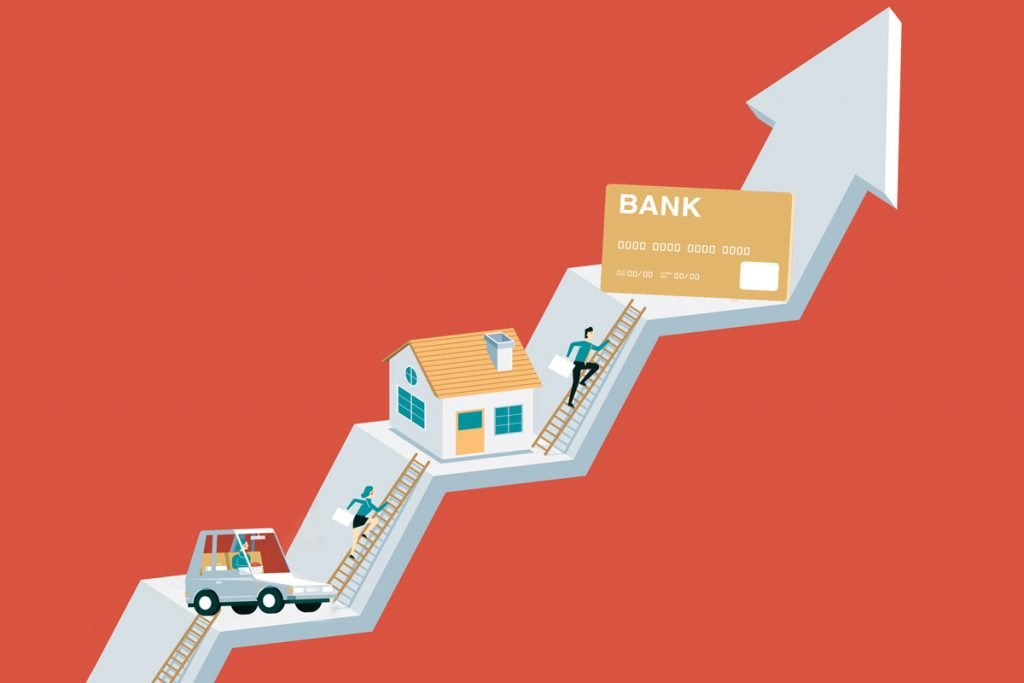by Kent McDill
Contributor
The Federal Reserve has hiked interest rates for the first time since 2018, partially due to consumer angst and anger about rising inflation. Have you seen the price of gas?
In general, a rate increase is good for savers and we may see some drops in prices of consumer goods. But the hike is not so fabulous for borrowers who will see mortgage and credit card rates jump.
Millennials and younger Generation Z have seen historically low mortgage rates all of their adult lives. First-time home buyers might be shocked, especially as rising interest rates collide with escalating home prices.
The quarter-point boost on March 16 to 0.25-0.50% could be the first of as many as six increases this year, according to Federal Reserve Chairman Jerome Powell. More increases in 2022 may be needed to battle both inflation, specifically rising cost of food and fuel, and the economic impact of sanctions against Russia for its aggression against Ukraine.
The Federal Reserve uses the benchmark interest rate to regulate the economy. The higher the interest rate, the more expensive it is to borrow money for purchases such as homes and cars, thus slowing commerce and battling inflation. The lower the interest rate, the less expensive it is to borrow money, thereby charging a sluggish economy.
Since December 2008, in response to the Great Recession, the benchmark rate has been unusually low, starting at near zero percent and rising to 2.25% in December 2018, about a year before the pandemic struck.
In response to the economic calamity caused by the pandemic, the interest rate dropped again to near zero in March 2020 and has not changed until now.
Thanks to the improving economy, supply chain issues and the Russian-Ukrainian conflict, inflation has risen to 4.7 percent as of March 22, and the Fed prefers to keep inflation around 2 percent.
Just to be clear, the federal interest rate is what financial institutions pay to borrow money from one another. But the rise and fall of that interest rate affects consumer interest rates on savings accounts, credit cards, mortgages and other personal loans.
Your credit is going to become more expensive. Most credit card companies provide variable rate interest, which means they can (and will) change interest rate on the balances you carry from month to month when the Fed raises interest rates overall.
The current average variable rate is 16.34%, according to BankRate. It will take a while for that rate to go up but you can expect the jump within a couple of months. Do what you can to pay down credit cards now.
It will be more expensive in the long run for you to make purchases on credit. If it is true that the Fed plans to continue to raise the benchmark rate, this might be a time to consolidate your debt to one with the lowest interest rate, or find a zero interest balance transfer offer that, for a limited time, would allow you to pay toward reducing the balance and not increase interest payments.
If you currently have a fixed rate mortgage, the interest hike will not impact your monthly payments. If your rate is variable, it is about to vary by becoming higher, and your monthly mortgage payment will rise.
The current average fixed mortgage rate for a 30-year loan is 4.45%, a 15-year average is 3.72% and the current average 10-year adjustable mortgage rate is 3.78%.
Should you want to refinance in response to the change in rates, the available bank rates are also going to rise in response to the Fed decision. The prime rate also impacts home equity lines of credit, so you should consider looking to reduce that debt amount.
Those consumers looking to buy a home can expect to pay more interest, which has been close to zero for quite a while. First-time home buyers might be the most affected because they will see increased interest rates with fast-rising home prices in many markets.
It’s going to cost more to buy a car on a payment plan, but not a great deal more.
Because of supply chain issues, new car prices are on the rise, and the increase in the offered interest rate on car loans is also going to go up. The pandemic-caused supply chain issues slowed delivery of new cars and decreased used car inventory.
Automobile loan rates are based on your credit score, and the current average rate for a credit score between 780-850 is 2.58%. It can climb to almost 10% for a low credit score.
Find out if your loan is a fixed rate loan (most federal loans are) or a variable rate loan. This is good information to have even though the pause on federal student loan payments will be in effect until May 1. It hasn’t been announced if the payment freeze will be extended for a fifth time.
Private loans can be refinanced the same way a mortgage is, and there will be competition among lenders for new business as a result of the new Fed prime rate.
It may be difficult for consumers to identify good news related to a rise in the federal prime interest rate. There should be, but the reality is that such news is rare and in the distance.
If you have a savings account, it is likely you are receiving less than 1% of interest on that account. The growth in savings accounts is low and has been since the Great Recession. In situations where the Fed raises prime rates for borrowing money, the rate offered by federally insured banks for saving money takes a very long time to respond in kind.
There are private banks that operate solely online that may offer higher rates for savings accounts of Certificates of Deposit, but the difference is going to be unimpressive. Still, any rate increase is better than no rate increase when it comes to savings.
We’ve rounded up the answers to some of the mostly commonly asked questions about rising interest rates.
The Federal Reserve uses the prime interest rate to stimulate or slow the economy, based on current economic patterns. With inflation reaching over 4% and the supply chain issue further driving up the cost of living for everyone, the Fed decided to raise the rate to slow borrowing and purchases on big ticket items like homes and automobiles. Such action is aimed at slowing inflation, although Fed chairman Jerome Powell said that there could be six more similar increases in the prime rate through 2022, and an increase of an additional 1.5% would definitely impact both inflation (positively) and employment (negatively).
When the Federal Reserve increases the benchmark interest rate for borrowing, both public and private lenders follow suit. As a result, any interest cost included in a purchase is going to increase. Mortgage rates and all loans will see increased interest rates for borrowing, and the interest rate on your credit card balances is likely to move upward as well.
Generally, it means the economy is booming, and doing so too fast for the good of the country’s consumers, whose income cannot keep up. When the Fed increases the prime interest rate, it is usually aimed at reducing the annual inflation rate, which indicates how much the cost of consumer items change from one year to the next.
The interest rate hike won’t affect your mortgage, if you have a fixed-rate mortgage. If you have a variable rate mortgage, that rate is likely to increase slightly, and will change again if the Fed goes ahead and makes more benchmark rate increases throughout 2022. This might be a good time to consider a refinance to a fixed-rate mortgage to avoid surprises down the line.
When it comes to spending or borrowing money, there are no disadvantages other than overextending yourself by acquiring too many loans or credit cards. When it comes to savings, low interest rates make it unappealing. Since the Great Recession, savings have fallen dramatically among Americans in part because interest rates are so low (in some cases at 0%), that savings serves no purpose. It’s no different than putting the cash under your mattress. However, an increase in interest rates is unlikely to produce a similar increase in savings account interest rates, at least in the short term.
Kent McDill is a veteran journalist who has specialized in personal finance topics since 2013. He is a contributor to The Penny Hoarder.
Ready to stop worrying about money?
Get the Penny Hoarder Daily
Privacy Policy
© 2022 The Penny Hoarder. – All rights reserved.
Privacy Policy and Terms of Service | Do Not Sell My Personal Information | Cookies Settings






